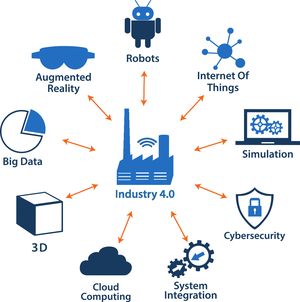KANBrief 4/17

Everyone's talking about "Industry 4.0". But what exactly is meant by this "fourth industrial revolution", and what conditions must be in place for it to be brought about? Are completely new technologies really being developed, or is existing technology merely being repackaged?
On 20 August 2013, the German Federal Government adopted the "Digital Agenda 2014-2017". With public investment of up to €40 billion a year, it is pursuing the objective of digitalizing industry in order to safeguard Germany's status as an industrial location in the long term (Federal Ministry for Economic Affairs and Energy, BMWI). This digitalization is being described as the fourth industrial revolution, or "Industry 4.0" for short. The term "Industry 4.0" has strong appeal in industry, research and education, and is therefore at times used somewhat loosely.
Old technology in a new wrapping?
Some of the technologies that are being described as "Industry 4.0" substantially predate the fourth industrial revolution currently being heralded. The (Industrial) Internet of Things, big data, artificial intelligence, the Cloud and robots are issues in their own right, and are not new. They form the essential technical basis for Industry 4.0, and are being linked and applied more intensively than before. The innovative characteristic of Industry 4.0 lies in components being able to communicate with each other and act autonomously, independently of vendor and beyond the confines of a given company.
Robots initially lead to a high level of automation. Even robots working collaboratively directly alongside human beings do not necessarily constitute "Industry 4.0".
When everyday items are equipped with microprocessors and additional sensors for recording their environments (such as temperature and sound volume), the result is a smart product. An additional wireless chip makes the product in question uniquely identifiable and enables it to communicate with other objects over the Internet. Networking of this kind is described as the Internet of Things (IoT) (pdf, in german). When this concept is applied to industrial goods and to networking between them, the result is described as the Industrial Internet of Things (IIoT).
IIoT generates a huge and above all complex body of data: "big data". Artificial intelligence can be used to analyse and recognize patterns in such large bodies of data. The combination of the two is intended to enhance the adding of value (by process optimization, the sale of data, etc.). The Cloud permits permanent access to these data from any location outside a company.
In order for the exchange of this information to be made vendor-independent, standardized interfaces, protocols and methods are required for the organization and control of industrial processes. In Germany, the first step entailed development of a reference architecture model for Industry 4.0. This model, RAMI 4.0, is described in DIN SPEC 91345:2016-04. The American equivalent is the Industrial Internet Reference Architecture (IIRA). In order to prevent parallel worlds from emerging, attempts are being made to link the two models (pdf, in german). Global agreement on a harmonized reference architecture is an essential requirement for the realization of Industry 4.0.
The standardized transmission, reception and storage of data enables data and products to be processed and developed further independently of vendor. Additional software enables individual components to act autonomously. This in turn enables new types of service to be developed, offered, applied, and combined with each other in the most diverse ways. In order for all this to be realized, aspects of both product safety and information security must be considered (See also: KANBrief 2/17; Source and further information: Manzei, Schleupner, Heinze (eds.): Industrie 4.0 im internationalen Kontext, 2017).
Industry 4.0 = smart manufacturing?
Industry 4.0 and smart manufacturing are frequently associated with each other. The terms are not identical in meaning, however. Industry 4.0 constitutes the technical premise for a form of smart production which for example is self-configuring and produces a one-off, custom-configured product at the same cost as a mass-produced item. ISO's Smart Manufacturing Coordinating Committee is currently formulating a definition of "smart manufacturing".
Sebastian Korfmacher
korfmacher@kan.de